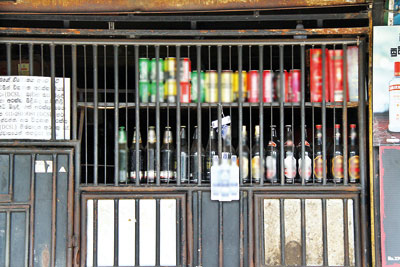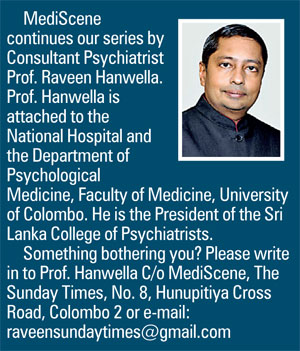A lot of bottle –Some myths and realities about alcohol
Nearly three decades ago,when starting my career in psychiatry, I asked my teacher and mentor Diyanath Samarasinghe why he has chosen to devote so much of his professional life to educating and campaigning against the use of alcohol and tobacco. I still remember his answer. He said, “A person has to choose what he would do in life and I decided to make alcohol and tobacco my primary focus since they are the two most important preventable causes of human misery in the world”. His words remain true even today.

One effective strategy to reduce alcohol consumption is the restriction on hours of sale and the density of liquor outlets. Pic by Indika Handuwala
The first part of the title for my article is taken from a book by Derek Rutherford. The writer who came out of the temperance movement he is now nearing the end of his career but remains the chairman of the Global Alcohol Policy Alliance. His book first published in 1988 is now out of print. Here is what he says in the preface. “There is in fact an industry whose product is considered to contribute to: 40,000 premature deaths in the United Kingdom, at least 1000 deaths of children and young people each year, one in five patients occupying general hospital beds, two of three attempted suicides, half of all crime, half of all cases of battered wives, half of all homicides, two out of five fires. Would you think that something ought to be done about it? The industry is the drink trade and the product is alcohol.”
What is alcohol? There are different types but the variety that is consumed is ethyl alcohol. It is produced when natural sugars in fruits, grains or vegetables are acted upon by yeast in a process called fermentation. Beer is produced by the fermentation of barley whereas wine is produced by the fermentation of grapes. Spirits, a stronger alcoholic brew is produced by boiling fermented liquors. Alcohol boils at a lower temperature than water and the vaporised alcohol is condensed in tubes. To be classed as a spirit it must contain at least 20% alcohol. Beer has about 4-7 percent ethyl alcohol, wines from 10-20 percent and spirits such as whisky and vodka 40-50 percent.
Let us look at some of the problems associated with alcohol in more detail. There are two main medical conditions associated with alcohol. When a person consumes a large amount of alcohol in one sitting he becomes intoxicated or drunk. If a person consumes a significant quantity of alcohol over a period of time he may become addicted or dependent. Alcohol dependence has two main characteristics, tolerance and withdrawal symptoms. When persons become tolerant to alcohol they can drink larger amounts without showing any apparent effects. When dependent individuals suddenly stop drinking they experience characteristic withdrawal effects such as tremors, sweating, elevated blood pressure and, in severe withdrawal or delirium tremens, confusion and even death.
 Alcohol consumption affects all organs of the human body. The Royal College of Physicians in the early 80s proposed safe limits for the United Kingdom of 21 units a week for men and 14 for women with one unit being 8 grammes of alcohol. To translate that into understandable terms, a glass of wine has one unit, a pint of beer two units and a bottle of spirits 30 units of alcohol. It was thought that if a person consumed alcohol within these limits he or she would not suffer any damage to their organs. However, this view is no longer supported by evidence. Latest studies show that any amount of alcohol raises the risk of cancer, the risk being greater if your consumption is more.
Alcohol consumption affects all organs of the human body. The Royal College of Physicians in the early 80s proposed safe limits for the United Kingdom of 21 units a week for men and 14 for women with one unit being 8 grammes of alcohol. To translate that into understandable terms, a glass of wine has one unit, a pint of beer two units and a bottle of spirits 30 units of alcohol. It was thought that if a person consumed alcohol within these limits he or she would not suffer any damage to their organs. However, this view is no longer supported by evidence. Latest studies show that any amount of alcohol raises the risk of cancer, the risk being greater if your consumption is more.
All persons who drink are not addicted. Is it necessary that all who drink should reduce their drinking? Why not target only those who have problems with alcohol? It was Sir Geoffrey Rose, the great epidemiologist who pointed out the Prevention Paradox in 1981. Applied to drinking the argument goes like this. The number of units a person consumes per day if plotted on a graph would follow a bell-shaped curve starting at zero. Some members of the population do not drink at all, a few drink heavily and the majority drink an average amount. To reduce the number who drink heavily you have to shift the entire curve to the left. That means that all persons have to drink a bit less. The paradox is that though the benefit of this reduction is minimal for the individual it is significant for the entire population. Indeed there is evidence to support this. The majority of experts agree that the number of individuals harmed by alcohol depends on the average per capita consumption of alcohol. It is a simple equation, higher the alcohol consumption, more the alcohol-related social and health harm. Lower the alcohol consumption, less the alcohol-related social and health harm.
What is the most effective way to reduce total alcohol consumption in a society? It has been repeatedly shown that the most effective way is to increase the price of alcohol. It has been argued that increasing the price of licit alcohol would drive people to drink illicit alcohol and thereby suffering more health damage. This is untrue. When the price of licit alcohol is raised, the price of illicit alcohol too increases. All drinkers reduce their average consumption. The effect on the health of a country of such a move is significant. In 1981 in Britain when the price of alcohol relative to average disposable income was increased for the first time in 30 years, average consumption fell by 15 percent. This translated to a 16 percent reduction in offences due to drunkenness, a 4 percent decrease in drunk driving and a 4 percent reduction in cirrhosis deaths.
Another effective strategy is the restriction on hours of sale and the density of liquor outlets. This aspect was highlighted recently when a prominent minister suggested that closing liquor outlets on Poya days actually increased alcohol consumption. His argument was that people who drink would in anticipation buy and stock their alcohol prior and drink even more. Barbor in his influential book, Alcohol, No Ordinary Commodity, highlights 10 best practices (besides alcohol taxes) in preventive alcohol policies. Some of these are interventions in the physical availability of alcohol such as the minimum purchase age, government alcohol monopolies, and restrictions on the times of sale and the density of outlets selling alcoholic beverages. He writes, “In sum, there is strong and reasonably consistent evidence from a number of countries that changes to hours or days of trade have significant impacts on the volume of alcohol consumed and on the rates of alcohol-related problems. When hours and days of sale are increased, consumption and harm increase and vice versa”.
I end with a quote from Derek Rutherford, “The Government has to strike a balance between freedom for those wish to drink, whilst minimising the adverse effects on society as a whole. Whilst state prohibition of alcohol is on no one’s agenda, even the most extreme adherents of the market force philosophy must recognise that no drug can be retailed like food or commodities. And alcohol is a drug. If it had been invented today, it would never have been legalised.


